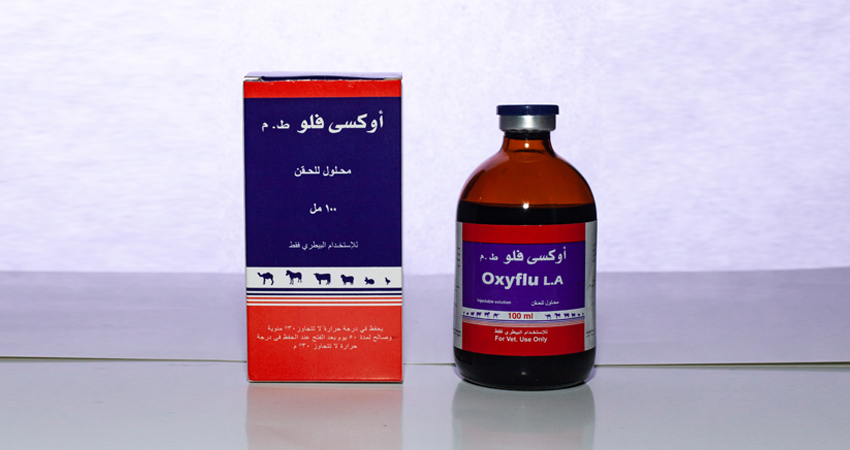Composition
Each 100 ml contains:
Oxytetracycline dihydrate 32.00 gm
Equivalent to Oxytetracycline base 30.00 gm
Flunixin meglumine 3.32 gm
Equivalent to flunixin base 2.00 gm
Properties
- Oxytetracycline inhibits protein synthesis in susceptible microorganisms. A wide range of organisms are known to be sensitive in vitro to oxytetracycline, including Pasteurella spp, Arcanobacterium pyogenes, Staphylococcus aureus and certain mycoplasmas.
- After oxytetracycline diffuses through the outer bacterial cell membrane, an active carrier mediated process transports the drugs through the inner cytoplasmic membrane. Inside the cell, oxytetracycline binds irreversibly to receptors on the 30S sub-unit of the bacterial ribosome where it interferes with the binding of the aminoacyl- transfer RNA to the acceptor site on the messenger RNA ribosome complex. This effectively prevents the addition of amino acids to the elongating peptide chain, inhibiting protein synthesis.
- Flunixin meglumine is a relatively potent non- narcotic, non-steroidal analgesic with anti- inflammatory, anti-endotoxic and anti-pyretic properties.
- Flunixin meglumine acts as a reversible inhibitor of cyclo-oxygenase, an important enzyme in the arachidonic acid cascade pathway which is responsible for converting arachidonic acid to cyclic endoperoxides. Consequently, synthesis of eicosanoids, important mediators of the inflammatory process involved in central pyresis, pain perception and tissue inflammation, is inhibited. Through its effects on the arachidonic acid cascade, flunixin also inhibits the production of thromboxane, a potent platelet pro-aggregator and vasoconstrictor which is released during blood clotting. Flunixin exerts its antipyretic effect by inhibiting prostaglandin E2 synthesis in the hypothalamus. By inhibiting the arachidonic acid cascade pathway, flunixin also produces an anti-endotoxic effect by suppressing eicosanoid formation and therefore preventing their involvement in endotoxin associated disease states.
Indications
Oxyflu L.A is indicated for the treatment of bovine respiratory disease associated with Mannheimia haemolytica (Pasturella multocida) where an anti- inflammatory and anti-pyretic effect is required.
Target species
Cattle
Dosage & Administration
By deep intramuscular administration to cattle.
1 ml Oxyflu L.A / 10 kg bodyweight on a single occasion
Warnings & Precautions
- Maximum volume per injection site: 15ml. If concurrent treatment is administered use a separate injection site
- Avoid intra-arterial injection.
- Do not exceed the stated dose or duration of treatment
Contra Indications
- Not for use in cattle producing milk for human consumption
- Not used in animals suffering from cardiac, hepatic or renal disease, where there is a possibility of gastrointestinal ulceration or bleeding or where there is hypersensitivity to the product.
- Avoid use in dehydrated, hypovolaemic or hypotensive animals as there is a potential risk of increased renal toxicity.
- Do not administer other NSAIDs concurrently, or within 24 hours of each other.
- Concurrent use of potentially nephrotoxic drugs should be avoided.
Side Effects
- The use of tetracyclines during the period of tooth and bone development, including late pregnancy, may lead to discolouration.
- Although the product is well tolerated, occasionally a local reaction of a transient nature may be observed
Withdrawal time
Cattle:
slaughter 35 days, Milk not used
Storage condition
Store at temperature not exceeding 30°C and valid after opening for 50 days in temperature not exceeding 30°C.
Packaging
Glass vials : 20 , 30 , 40 , 50 , 100 & 250 ml .

